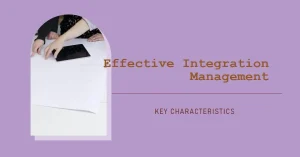Introduction
Feedback serves as a vital tool that can significantly influence the trajectory of a project. Constructive feedback is defined as information that is specific, issue-focused, and actionable, aimed at improving performance and fostering growth. It plays a crucial role in project management by not only guiding project managers in assessing their team’s performance but also in enhancing the overall effectiveness of project execution.
The importance of feedback cannot be overstated; it is essential for enhancing team performance and achieving successful project outcomes. Regular and well-structured feedback helps team members understand their strengths and areas for improvement, ultimately leading to increased productivity and sharper deliverables. By implementing a feedback loop, project managers can ensure that their teams remain aligned with project goals, adapt to challenges, and continuously improve their processes and outputs [11][15].
This blog will delve into the various aspects of constructive feedback in project management. We will explore the following key areas:
- Defining Constructive Feedback: A closer look at what constitutes constructive feedback and how it differs from general feedback.
- The Impact of Feedback on Team Performance: An examination of how effective feedback can lead to enhanced collaboration, trust, and overall project success.
- Strategies for Delivering Effective Feedback: Practical tips and methods for project managers to provide feedback that is clear, specific, and actionable.
- Creating a Feedback Culture: Insights into fostering an environment where feedback is valued and regularly exchanged among team members.
By understanding and mastering the art of constructive feedback, project managers can transform not only their teams but also the outcomes of their projects, paving the way for success in an increasingly complex and dynamic work environment.
Understanding Constructive Feedback
Constructive feedback is a vital component of effective project management, serving as a tool for enhancing team performance and project outcomes. It is essential for project managers and team leaders to grasp the nuances of constructive feedback to foster a supportive and productive work environment.
Definition and Characteristics of Constructive Feedback
Constructive feedback is defined as specific, actionable, and supportive commentary aimed at improving an individual’s performance or behavior. Its key characteristics include:
- Specificity: Constructive feedback should focus on particular behaviors or actions rather than generalizations. This clarity helps team members understand exactly what needs improvement [10].
- Timeliness: Providing feedback soon after the observed behavior ensures that the information is fresh in the recipient’s mind, making it more relevant and impactful [10].
- Constructiveness: The feedback should be delivered in a supportive manner, emphasizing growth and development rather than merely pointing out flaws [10][6].
- Balance: Unlike vague criticism, constructive feedback is balanced and supportive, focusing on both strengths and areas for improvement [7].
Difference Between Constructive Feedback and Criticism
While both constructive feedback and criticism aim to address performance issues, they differ significantly in their approach and impact:
- Focus: Constructive feedback is centered on behaviors and actions related to work, whereas criticism often targets the individual personally, which can lead to defensiveness and disengagement [12][11].
- Tone: Constructive feedback is delivered in a supportive tone, encouraging improvement, while criticism can be overly negative or harsh, potentially demotivating team members [11][7].
- Outcome: The goal of constructive feedback is to inspire positive change and professional development, whereas criticism may not provide a clear path for improvement, leaving individuals feeling discouraged [3][15].
Psychological Impact of Constructive Feedback on Team Members
The psychological effects of constructive feedback are profound and can significantly influence team dynamics and individual performance:
- Increased Engagement: When team members receive constructive feedback, they feel supported and valued, which can lead to higher levels of engagement and motivation [15].
- Enhanced Learning: Constructive feedback fosters a culture of continuous improvement, encouraging team members to learn from their mistakes and strive for excellence [13].
- Reduced Anxiety: By focusing on specific behaviors rather than personal attributes, constructive feedback helps reduce anxiety and fear of failure among team members, creating a safer environment for open communication [6][10].
The Benefits of Feedback for Project Managers
Effective feedback is a cornerstone of successful project management, offering numerous advantages that can significantly enhance project outcomes. Here are some key benefits of giving and receiving feedback in project management:
- Enhances Team Communication and Collaboration: Regular feedback fosters open lines of communication among team members. By sharing insights on performance and progress, project managers can ensure that everyone is aligned with the project goals. This clear and honest communication helps prevent misunderstandings and keeps the team focused on their objectives, ultimately leading to a more cohesive working environment [4][12].
- Fosters a Culture of Continuous Improvement and Learning: Feedback is essential for creating an environment where team members feel encouraged to learn and grow. By implementing regular feedback loops, project managers can help identify areas for improvement, allowing teams to adapt and refine their processes in real-time. This culture of continuous improvement not only enhances individual performance but also contributes to the overall success of the project [9][10].
- Improves Project Outcomes by Addressing Issues Early: Timely feedback allows project managers to identify and address potential issues before they escalate into significant problems. By providing constructive feedback early in the project lifecycle, managers can guide their teams toward making necessary adjustments, thereby improving the quality of deliverables and ensuring that the project stays on track [2][12].
- Builds Trust and Accountability Within the Team: Establishing a feedback-rich environment helps build trust among team members. When feedback is delivered in a constructive manner, it encourages accountability and ownership of tasks. Team members are more likely to take responsibility for their work when they know that their contributions are recognized and valued, leading to a more motivated and engaged team [11][13].
Best Practices for Providing Constructive Feedback
Effective feedback is a cornerstone of successful project management, as it not only enhances individual performance but also contributes to the overall success of the project. Here are some actionable strategies for project managers to provide constructive feedback that can transform project outcomes:
- Be Specific and Focused on Behavior: When delivering feedback, it is crucial to be clear and specific about the behaviors that need to be addressed. Avoid generalizations and focus on observable actions rather than personal attributes. This approach helps team members understand exactly what they need to change and why it matters, leading to more effective improvements in their performance [1][7].
- Use the ‘Sandwich’ Method: This technique involves framing constructive criticism between two positive comments. Start with positive feedback to acknowledge what the team member is doing well, then introduce the constructive criticism, and conclude with another positive remark. This method not only softens the impact of the criticism but also reinforces the individual’s strengths, making them more receptive to the feedback [7][14].
- Encourage a Two-Way Dialogue: Feedback should not be a one-sided conversation. Encourage team members to share their thoughts and feelings about the feedback they receive. This two-way dialogue fosters an environment of openness and trust, allowing for a more collaborative approach to performance improvement. It also helps project managers understand the perspectives of their team members, which can lead to more effective solutions [3][4].
- Timing and Environment: The timing and setting of feedback delivery are critical. Choose a moment when the team member is likely to be receptive, and ensure the environment is conducive to a constructive conversation. Providing feedback in real-time, either face-to-face or via video chat, allows for immediate clarification and discussion, which can enhance understanding and retention of the feedback [8][9][12].
By implementing these best practices, project managers can create a culture of continuous improvement and engagement within their teams, ultimately leading to better project outcomes and a more motivated workforce.
Receiving Feedback: A Project Manager’s Perspective
The ability to receive and act on feedback is crucial for both personal and project success. Constructive feedback not only enhances project outcomes but also fosters a culture of continuous improvement within teams. Here are some key points to consider:
Cultivate a Mindset of Openness and Willingness to Improve
- Embrace a Growth Mindset: Project managers should adopt a growth mindset, viewing feedback as an opportunity for development rather than criticism. This perspective encourages a proactive approach to learning and adaptation, which is essential in dynamic project environments [11].
- Create a Safe Environment: Establishing a culture where team members feel safe to share their thoughts is vital. This can be achieved by promoting open communication and demonstrating that all feedback, whether positive or negative, is valued and taken seriously [11].
Methods for Soliciting Feedback from Team Members and Stakeholders
- Regular Check-ins: Schedule consistent meetings, such as weekly or bi-weekly check-ins, to discuss project progress and solicit feedback. This not only keeps everyone aligned but also encourages ongoing dialogue about project performance [12].
- 360-Degree Reviews: Implementing 360-degree feedback mechanisms allows project managers to gather insights from various stakeholders, including team members, clients, and peers. This comprehensive approach provides a well-rounded view of performance and areas for improvement [9].
- Anonymous Surveys: Utilizing anonymous surveys can help gather honest feedback from team members who may feel uncomfortable sharing their thoughts openly. This method can uncover valuable insights that might otherwise go unvoiced [15].
How to Process and Implement Feedback Effectively
- Prioritize Feedback: Not all feedback will be equally relevant or actionable. Project managers should assess the feedback received, prioritizing it based on its potential impact on project outcomes and team dynamics [10].
- Develop an Action Plan: After processing feedback, create a clear action plan that outlines how to address the identified issues. This plan should include specific steps, timelines, and responsible parties to ensure accountability [13].
- Follow Up: After implementing changes based on feedback, it is essential to follow up with the team to assess the effectiveness of those changes. This not only demonstrates that feedback is valued but also reinforces a culture of continuous improvement [10].
Creating a Feedback Culture within the Team
Fostering a culture of constructive feedback is essential for project managers aiming to enhance team performance and project outcomes. By creating an environment where feedback is valued and encouraged, project managers can significantly improve collaboration, innovation, and overall project success. Here are some key strategies to cultivate this feedback culture:
- Encourage Regular Feedback Sessions and Check-Ins: Establishing a routine for feedback sessions helps normalize the process and makes it a regular part of team dynamics. These sessions should be concise and focused, allowing team members to absorb key points effectively. By keeping discussions centered on one or two specific areas, project managers can ensure that feedback is actionable and clear, which enhances understanding and implementation [2][9].
- Implement Tools and Practices that Facilitate Feedback: Utilizing various tools and practices can streamline the feedback process. For instance, conducting surveys and retrospectives can provide structured opportunities for team members to share their insights and experiences. These methods not only gather valuable input but also encourage a culture of continuous improvement by allowing teams to reflect on their performance and identify areas for growth [3][14].
- Recognize and Reward Team Members Who Actively Engage in Giving and Receiving Feedback: Acknowledging the efforts of team members who contribute to the feedback culture is crucial. Celebrating those who participate actively in feedback processes fosters a sense of ownership and encourages others to engage as well. This recognition can take various forms, from verbal praise during meetings to formal rewards, reinforcing the importance of feedback in the team’s success [12][13].
By implementing these strategies, project managers can create a supportive environment that not only values feedback but also leverages it to drive project success. A well-established feedback culture leads to improved communication, enhanced team engagement, and ultimately, better project outcomes.
Challenges in Giving and Receiving Feedback
Effective feedback is a cornerstone of successful project management, yet it often presents significant challenges for project managers and team leaders. Understanding these obstacles and developing strategies to overcome them can lead to improved project outcomes and team dynamics.
Common Fears Associated with Giving Feedback
- Fear of Conflict: Many project managers hesitate to provide feedback due to the potential for conflict. They worry that their comments may lead to defensiveness or disagreements, which can disrupt team harmony. This fear can result in avoidance, leading to unresolved issues that may escalate over time [5][14].
- Fear of Demotivation: There is a concern that providing critical feedback might demotivate team members. Managers often worry that their comments could be perceived as personal attacks rather than constructive criticism, which can diminish morale and productivity [5][14].
- Lack of Communication Skills: Some project managers may struggle with effectively articulating their feedback. This lack of communication skills can hinder their ability to convey messages clearly and constructively, leading to misunderstandings and frustration [15].
Discomfort in Receiving Feedback
Receiving feedback can be equally challenging for project managers. Many individuals experience discomfort when faced with criticism, which can lead to emotional responses that cloud their judgment. Here are some strategies to cope with this discomfort:
- Adopt a Growth Mindset: Embracing a growth mindset allows project managers to view feedback as an opportunity for personal and professional development. This perspective can help mitigate feelings of defensiveness and encourage a more open reception to constructive criticism [8].
- Practice Active Listening: Engaging in active listening during feedback sessions can help project managers fully understand the feedback being given. This involves not only hearing the words but also interpreting the underlying messages and emotions, which can lead to more meaningful discussions [8].
- Seek Clarification: If feedback is unclear or feels overwhelming, project managers should not hesitate to ask for clarification. This can help ensure that they fully understand the feedback and can act on it effectively [11].
Importance of Emotional Intelligence in Feedback Scenarios
Emotional intelligence (EI) plays a crucial role in both giving and receiving feedback. Project managers with high EI can navigate the complexities of interpersonal relationships more effectively, leading to better outcomes in feedback situations. Here are some key aspects of EI that can enhance feedback processes:
- Empathy: Understanding the emotions and perspectives of team members can help project managers tailor their feedback in a way that is constructive and supportive. Empathy allows managers to connect with their team on a personal level, fostering a culture of trust and openness [15].
- Self-Regulation: Project managers who can manage their own emotions are better equipped to handle challenging feedback scenarios. This self-regulation helps them remain calm and composed, even when faced with difficult conversations [15].
- Social Skills: Strong social skills enable project managers to communicate effectively and build rapport with their teams. This can facilitate more productive feedback sessions, where team members feel safe to express their thoughts and concerns [15].
Conclusion
The ability to provide and receive constructive feedback is not just a skill; it is an art that can significantly transform project outcomes. Effective feedback fosters an environment of open communication, enhances team collaboration, and ultimately leads to improved project performance. By focusing on specific behaviors rather than personal attributes, project managers can create a culture where feedback is viewed as a valuable tool for growth rather than criticism. This approach not only helps in addressing areas of improvement but also reinforces positive behaviors that contribute to the success of the project.
Project managers are encouraged to implement the feedback strategies discussed throughout this blog. These strategies include being clear and direct, providing timely feedback, and ensuring that the feedback is constructive and supportive. By adopting these practices, project managers can cultivate a more engaged and motivated team, leading to better project outcomes and a more harmonious work environment.
Find out more about Shaun Stoltz https://www.shaunstoltz.com/about/.
This post was written by an AI and reviewed/edited by a human.



